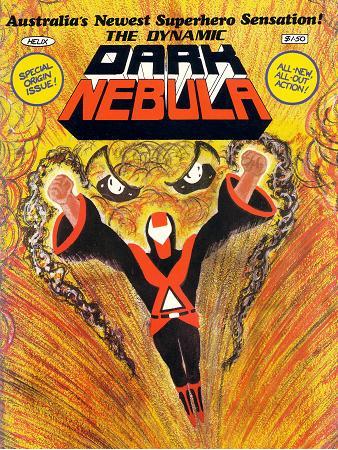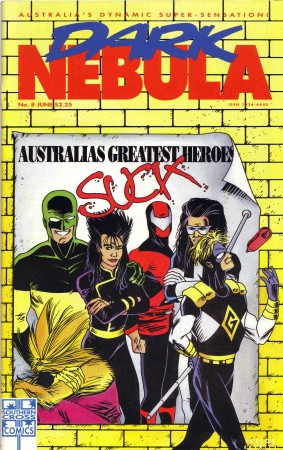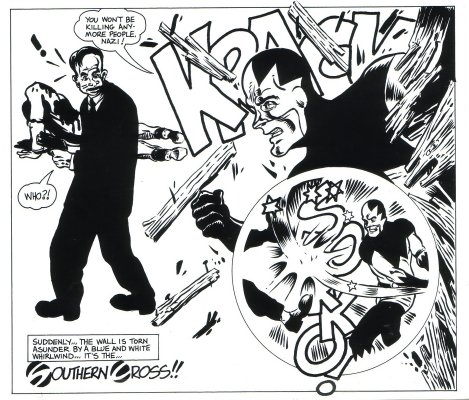Australian Comics
COVER GALLERY
A History of the scene
Adventures of Andy in Comicland
Tale-Trader The Legend of Twarin
The Tiger Who Wanted to be Human
INTERVIEWS
Tad Pietrzykowski
REVIEWS
OTHER
Hellblazers Delano and Ennis
Tad Pietrzykowski
An interview by David Carroll, December 2003
 The original graphic novel (art by Tad Pietrzykowski) |
Tad Pietrzykowski is one of the pioneers of the Australian comic industry. The appearance of his graphic novel The Dynamic Dark Nebula in 1982 was the first hint of the strong commercial industry that existed in the mid to late 80s. Tad was present throughout that era, as Dark Nebula moved from its own title to the pages of Cyclone!, and then back to its own title again. He also worked on the Golden Age Southern Cross, perhaps our most pure pulp creation.
Here Tad talks about that work, his plans that didn't quite make it the first time around, and why he is now returning to the scene, to present his vision to a new generation.
Tabula Rasa: Where did you grow up?
Tad Pietrzykowski: Tempe, in Sydney -- very suburban, very urban and yes, when I was a kid I used to play in the famous Tempe Tip.
TR: When did you start doing comics?
TP: That's a toughie -- it probably all started when my dad first introduced me to them when I was 5. I knew when I started reading comics that I wanted to create, and it was then I used my own imagination not to create stories of existing characters but of my own. Over the years I must have devised hundreds of different characters, each hopefully better than the previous ones, and eventually I'd let them go. Some I vaguely remember, most I've (probably thankfully) forgotten. Some I had to abandon because other creators had already released characters not unlike them. For example I thought of a character who could transform to organic steel years before Marvel released Colossus in the X-Men -- but I was a kid at the time and I thought, 'Oh well', and moved on. By that stage I'd already devised the foundations for the Dark Nebula. The concept stayed with me like a constant companion throughout school and college as I continued to pull and tweak away at the idea. I couldn't tell you how many drafts I went through before I got to the end-result, but it was a lot!
TR: Did growing up in Australia affect your comics at all?
TP: Most certainly. Being Australian helped set the tone and shape the identity of the characters. Otherwise it might have been indistinguishable from other comic characters. On the downside, without a comic industry as such in this country the title didn't get as good a run as I thought it might have, given a chance in the U.S. My interest in the characters continues undiminished after all these years.
TR: What other influences were there?
TP: Practically everything I read, both in and out of comics. It wasn't till after I released the Graphic Novel that I realised how much influence Green Lantern had on my character. I was always a fan of the best of mainstream Marvel and DC titles. Roy Thomas wrote the book on team dynamics with what he did on Avengers and X-Men. Chris Claremont on characterization. Jack Kirby on just about everything. John Byrne -- I was a fan of his stuff before he was popular. I enjoyed his early stuff from Charlton comics as it was being released. Then when he shifted to Marvel I was buying his Iron Fist as it came out. The Claremont/Byrne team meant a lot to me well before they moved on to X-Men. Funnily enough though, when I was actually illustrating, for the brief time I did so, someone commented on how much influence Steve Ditko had on my art -- and they were right too. I was a huge Ditko fan -- still am -- but didn't even see the influence he had on me artistically to me till someone pointed it out to me. Jim Starlin was another favorite of mine, probably also because of the huge influence Ditko had on him, too.
TR: Why did you choose the format you did?
TP: With the Graphic Novel I went magazine size because I wanted it to stand out on the news-stands, but at a size that'd fit in with other magazine-sized comics in people's collections. Back in '82 there were still some titles being released at magazine size (e.g. Savage Sword of Conan), and in fact the first appearance of Nexus appeared on the news-stands (or comic shops) at exactly the same time The Dynamic Dark Nebula Graphic Novel was released -- it, too, was magazine-sized!
 Dark Nebula #8 (art by Jason Paulos) |
I remember at one point I proposed the Dark Nebula as a Sunday comic strip but that didn't go anywhere.
TR: How was original Graphic Novel distributed?
TP: I went with what I knew. At the time Gordon & Gotch was the only game in town and good at it. They distributed the title Australia-wide as well as throughout New Zealand. It sold reasonably well but, because I took advantage of a government subsidy called 'Book Bounty', the title had to be a one-off. A sequel couldn't be called The Dynamic Dark Nebula. The unpublished This Earth Alive was on the cards to be released as Dark Nebula Vs. Planet Earth or something like that -- then Cyclone came along.
TR: What experiences did you have upon publication?
TP: Apart from headaches? (laughs) A lot of very positive response. Before I did the Dark Nebula Graphic Novel in '82, the last attempt at an Australian Superhero was Brainmaster & Vixen. Others' efforts at Aussie comics started to appear months after mine (I think OzComics was in '83 sometime). The feedback was great! One letter I distinctly remember receiving was from a 12 year old Jason Paulos wanting as much information as I could provide about producing comic book artwork. It was a kick to meet him years later and to eventually have him as a regular artist on the title. My audience on that title ranged in age from 12 to 65 -- no joke!
TR: How did you see the coming together of Cyclone! comics, and how did your character change over the various incarnations?
TP: I met Gary Chaloner at the time I was publishing the Dark Nebula Graphic Novel. Glenn Lumsden and I were friends trading comics years before, and one of the reasons I illustrated the Graphic Novel was because Glenn Lumsden was doing the Higher School Certificate that year and was indisposed with studies. By the time he was available to illustrate material, it was for my third story, The Challenge of the Grandstander -- the original version of this appeared in Cyclone 1-3. In the meantime I illustrated an unpublished story This Earth Alive, which introduced another of my characters Planet Earth, a story I only recently discovered I don't have the artwork to. A version of this story appeared in Cyclone 4 and 5, illustrated by David de Vries, Shea Anton Pensa and Alex Drescher, but elements of the story that made the leap from the Graphic Novel to the Grandstander story were lost. The original version of The Chaos War featured Planet Earth instead of Cerellus. A lot of things went to the wayside, but in their place came mediation, moderation. Good writing always found its way around any dramas. By the time we reached the point of the regular Dark Nebula title, any hiccups in the continuity had been sorted out. The pacing on the title was pretty good considering we didn't have the luxury of a comic industry in this country. I knew we had to move things along at a reasonable pace, otherwise we might have been mid-way through a story and then nothing! At least when I reached the point I stopped at there were no loose ends. Sure, there was more I wanted (and still want) to do, but I always knew I could pick up where I left off, and know I didn't leave the audience cheated mid-story.
TR: Did you change the background of the comic to fit in with Cyclone? Were the other Cyclone titles influenced by your concepts?
TP: There was a lot of give and take to start with. I was in the habit of writing epic-length stories and to make them work in Cyclone they had to be serialised. It helped me tighten up the story-telling. By the time we got to the on-going title all the bugs were ironed out and I believe it resulted in a better title.
I think all the titles were influenced by each other on some level. My favorite baddie, the Grandstander, made recurring appearances in The Southern Squadron. The Golden Age Southern Cross and the modern-day version of the character had a unique crossover in The Southern Squadron. On the flipside David de Vries and I collaborated on the D.N. /Southern Squadron crossover in Dark Nebula #7 and 8. The original concept for the story was thought out long before I met the rest of the team at Cyclone, and other characters would have been used, but it was too good an opportunity to pass up. We were all proud of the end-result.
 The Golden Age Southern Cross (art by Glenn Lumsden) |
TP: The aforementioned Planet Earth, a former journalist who becomes the living embodiment of the Earth after surviving a bomb-blast. He was my ecological character. As Dark Nebula is the champion of the human race, Planet Earth was the champion of the planet itself but, because we don't live in harmony with the planet it brings these two at odds from time to time (the thrust of some of the new material I intend to release).
The Golden Age Southern Cross -- originally I started with a modern day descendant of 'the Golden Age Southern Cross', kind of our own Captain America, but more and more I leant towards doing the Golden Age character instead -- and besides, it was less complicated. I've worked in commercial radio for nearly 20 years now, and even before I started in the industry I was immersed in the history of radio, particularly the old Radio Serials (Theatre of the Mind), a time when radio was really worth listening to. The names of the characters were based on names of actual radio stars who performed at the Phillip St. Theatre and the old AWA Building in Sydney -- it's just a matter of wading through the right research to work out who's who. Eventually working with people who knew these people at one point or another had me jazzed too. I wanted the character to have an 'authentic' golden age origin (i.e. very simple), and to have a radio serial of a character called The Southern Cross and, through a series of events, for the author of the serial to actually become the character.
It was at this point Glenn Lumsden took over and gave the character the Eisnerish tone that it needed. As my focus leant towards Dark Nebula, so did Glenn lean towards the Southern Cross -- it helped define both and made them distinct from each other.
I still have stories to tell of Dark Nebula, Planet Earth and the Golden Age Southern Cross -- all comes to he who waits.
TR: Did you have any input into Dark Nebula's appearance in Cyclone Comics Quarterly?
TP: Oh, the Undertaker story. Not really. Just my consent. There was some speculation about my reaction after it was published, as it was a real departure from the material I did. I read it and thought 'nothing I can't write around'. If it comes to it I have a story which explains it, doesn't invalidate it and puts the book back on track. There's nothing worse than someone putting the eraser through a story because it doesn't suit.
TR: What are your current plans for the character?
TP: After a 12 year break I'm planning on continuing the adventures of the Dark Nebula on-line with thedarknebula.com, to eventually pick up where I left off and to introduce the characters to a wider audience. I've been toying with the notion for some years, but I never had the time between my career in radio and family commitments. This was prompted by a car accident I'm currently recovering from -- one I was lucky to survive. It's ironic that my character gains his power after coming back from the dead and he's given a new lease on life just as I was. It's amazing what you can do when you're unable to do the things you're used to. I'm currently a radio announcer with a wired jaw (you've got to love the irony!) -- for once everyone else gets the first and last word. I'm also glad we're doing this interview on-line, otherwise everything I said would be literally through gritted teeth.
So with all the time on my hands while in recovery I'm laying all the groundwork to get the project up and running -- Gary Chaloner has been an immense help. He's guiding me through the on-line side of it, having trod the path before me -- thanks Gaz!
 Planet Earth preview, art by Shane Foley |
The wealth of material that was done before deserves another airing 'for those who came in late', otherwise there's nothing worse than to come in mid-stream. Because the original version of This Earth Alive seems to have disappeared, Shane Foley and I are working on a newer prose version, not unlike the one that appeared in Cyclone 4 and 5 but tighter, to introduce Planet Earth early in the piece. In some ways I think it was harder remembering aspects of this story I haven't given a second thought to for nearly 20 years! Thankfully (and hopefully) I did.
After the material that has come before has been re-released, the never-released Dinosaurs In Tasmania will finally see the light of day (it was originally slated to be Dark Nebula #9), re-introducing Planet Earth, then the sequel to The Chaos War, The Chaos Theory, brings Cerellus back into the picture.
Blaze of Glory is a follow-on from aspects of Dinosaurs in Tasmania, and another Planet Earth story. Death Demands a Sacrifice is the answer to the riddle, how can a champion of life be created by Death?
Beyond that there's The Reality Schism, the follow-on to the Cyclone Quarterly Undertaker story, Lost in Space (remember, he is an astronaut) and The Trial of Jet Jackson.
It'll be interesting getting back into it all after such a long absence. I'm hoping it'll give me a fresh perspective on the story-telling process and that the on-line audience really takes to the characters.
I love tinkering around with these characters -- I set the rules for them and know how far I can 'stretch the envelope' with them, so to speak.
If for nothing else it'll be nice to get back in the game and to see what audience The Dark Nebula attracts.
Gallery
©2011 Go to top


